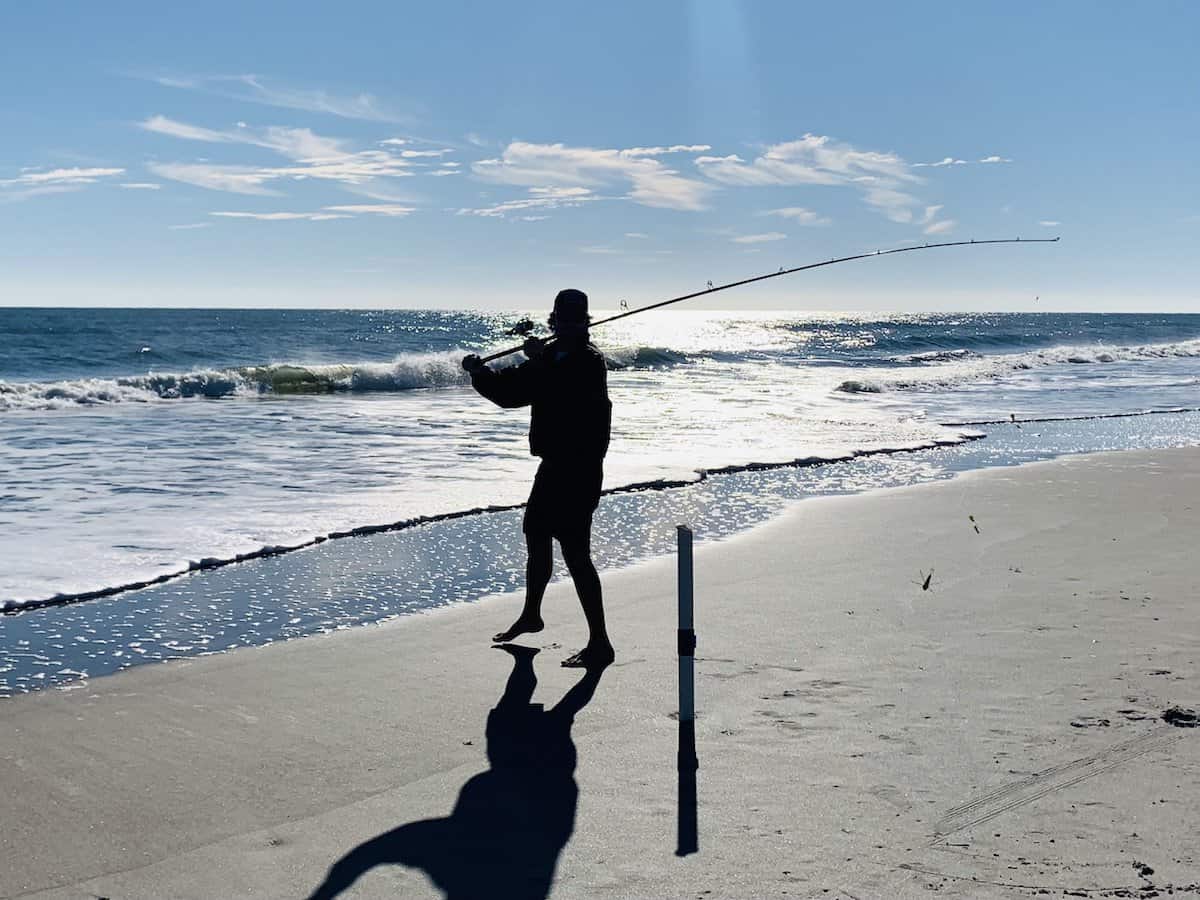Surf Fishing: When to Recast Bait/Lure
In general, a surfcaster should recast his/her line every 20 minutes to check on the bait. This is based on several factors including the type of bait used (live or artificial), and how rough the water is.
Casting Frequency with Live Bait
Live bait needs to be checked every 5-20 minutes depending on the type of bait used. Live shrimp, for example, is a little tricky to properly hook. If you don’t have much experience hooking a live shrimp, or if the waters are rough, reel in and check your bait more often. Shrimp is likely to fall off the hook or get nibbled by other creatures without getting a hook. If live shrimp is hooked properly, it can last a long time because fish will eat them alive or dead. Once you gain more experience and confidence with hooking shrimp, you can extend the time you leave it out. We’d recommend checking bait and recasting every 10 minutes when starting out with shrimp and extending it as your experience grows.
Sand fleas can be tricky as well. Sometimes if they’re “too alive”, they’ll burrow into the sand when you cast and there goes your chances of catching a fish. Experienced surfcasters recommend pinching the head when using a sand flea for bait to eliminate this from happening. Assuming your sand flea is not burrowed in the sand, you can expect a sand flea to last about 15 minutes before you need to check, replace, and recast.
Clams and bunker chunks (body) are also common live baits to use. These can be very effective due to the strong scents they emit. The waters will wash off the scent over time, so we recommend recasting every 15 minutes. When using a bunker head, the scent lasts substantially longer and you can leave your cast for about an hour, although we suspect you’d have a bite before then!
To learn more about when to use certain baits, read our article on the Best Baits for Surf Fishing.
How Often to Recast with Artificial Lures
Artificial baits need to be recasted every 20 minutes because the scent from the artificial attractant wears off. Whenever you are using artificial bait, like Gulp! Shrimp, make sure you put the lure back into the liquid/gel mixture when you take it off. These lures can be reused and putting them back in the attractant mixture, gets them back in prime condition for re-use. Be careful when choosing your artificial lure to ensure it's targeted for saltwater use. Saltwater causes rapid corrosion and saltwater lures are designed to resist corrosion much better. Surf fishing with a freshwater lure will most definitely cause a shorter lifespan for your lure.
Recasting in Rough Swells and Weeds
On a day with rough swells, recasting may need to occur more frequently. It’s not uncommon for a surfcaster to recast every 5 to 7 minutes on a day like this. With these kinds of waters, the fisherman will likely see the waves pushing the rig out of the target location and you are more likely to lose your bait as the waves sort of “shake” the bait off the hook. We’d recommend expecting to re-bait your hook pretty often in these situations.
Rough swells also tend to cause an increase in weeds in the water and on shore. Weeds present a different obstacle as they tend to collect on your line right where the line meets the water. A collection of weeds on your line will weigh it down and can make it harder to detect an actual bite. You’ll likely end up reeling your line in, clearing the weeds, and recasting. The frequency of the recasting heavily depends on the amount of weeds present.
I remember fishing at the beach at Patrick Air Force Base in Florida a couple days before a hurricane was coming. The swells were much larger than normal and they were washing ashore all kinds of weeds. We were getting frustrated because of how often we were having to reel in and recast because the weeds were getting caught on the line and the rigs weren’t staying in our target location. That was a tough day and eventually we stopped trying because of the frustration. We have since learned to use minimal rigs, keep our lines tight, and plan on recasting more frequently on these kinds of days. It can still be frustrating, but we have seen improvement when taking these steps. Now we look optimistically at these kinds of days and seize the opportunity to practice our casting skills!
One final note we’d like to make about recasting involves the temperature and time of day. For all of the times recommended above, you can add a good 5 minutes to your bait soak if you’re fishing in cold waters or at night!
Tight lines and high tides, y’all!
As an Amazon Associate I earn from qualifying purchases.
Recent Posts
Fat Cow Jig Strips: The Ultimate Bucktail Jig Upgrade for Surf Fishing
As discussed in my previous article, "Surf Fishing with Bucktail Jigs: Ultimate Guide for Beach Anglers," bucktail jigs are a staple in any surf angler's tackle box, offering a versatile way to catch...
In my previous article, "Surf Fishing with Bucktail Jigs: Ultimate Guide for Beach Anglers," I introduced you to the bucktail jig and discussed how versatile of a lure it is for catching a wide range...

